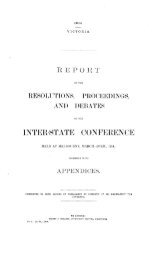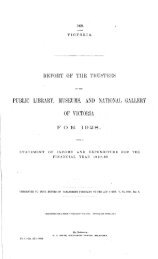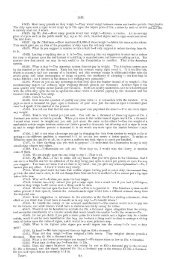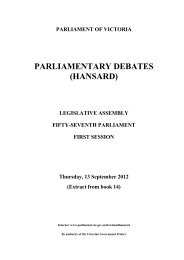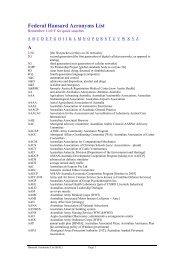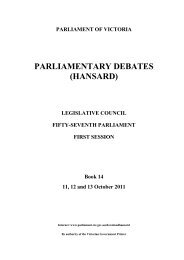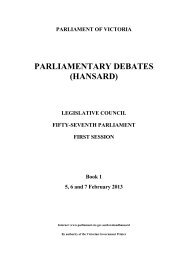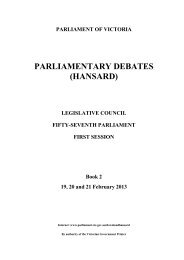Book 8 - Parliament of Victoria
Book 8 - Parliament of Victoria
Book 8 - Parliament of Victoria
Create successful ePaper yourself
Turn your PDF publications into a flip-book with our unique Google optimized e-Paper software.
QUESTIONS WITHOUT NOTICE<br />
Thursday, 2 June 2011 COUNCIL 1699<br />
and the commonwealth, and it has a good history <strong>of</strong><br />
bringing together datasets that enable genuine<br />
comparability. This is one alternative that would see<br />
good transparency with less bureaucracy.<br />
Supplementary question<br />
Mr JENNINGS (South Eastern Metropolitan) — I<br />
would like to congratulate the minister on providing the<br />
best answer he has given me, in my view, to any<br />
question I have asked him. In the spirit <strong>of</strong> being<br />
constructive, I ask the minister — —<br />
Mr P. Davis interjected.<br />
Mr JENNINGS — I still believe it is the best<br />
answer he has given. In the spirit <strong>of</strong> being constructive,<br />
I want to know whether it is the intention <strong>of</strong> the<br />
minister to account to the commonwealth so as to<br />
provide it with the confidence <strong>of</strong> knowing that every<br />
dollar the commonwealth allocates for health<br />
expenditure in <strong>Victoria</strong> will be acquitted within the<br />
health portfolio.<br />
Hon. D. M. DAVIS (Minister for Health) — This is<br />
not strictly a supplementary question, but nonetheless I<br />
am happy to answer it. It is a question that Mr Jennings<br />
has asked on a number <strong>of</strong> occasions, and I will give him<br />
the same answer I have given previously, which is a<br />
direct answer. The state spends far more on health care<br />
than the commonwealth does. The state’s contribution<br />
dwarfs the commonwealth’s contribution. In the case <strong>of</strong><br />
<strong>Victoria</strong> about 60 per cent <strong>of</strong> our hospital system costs<br />
are met by <strong>Victoria</strong> and not by the commonwealth. I am<br />
confident that we are pulling our weight and increasing<br />
our share. I am very happy to provide an assurance to<br />
the member that <strong>Victoria</strong> is more than pulling its<br />
weight.<br />
Higher education: federal funding<br />
Mr O’BRIEN (Western <strong>Victoria</strong>) — My question is<br />
to the Minister for Higher Education and Skills, who is<br />
also the Minister responsible for the Teaching<br />
Pr<strong>of</strong>ession, the Honourable Peter Hall, and I ask: can<br />
the minister inform the house <strong>of</strong> the Liberal-Nationals<br />
coalition government’s position on commonwealth<br />
legislation to create a demand-driven funding system<br />
for higher education?<br />
Hon. P. R. HALL (Minister for Higher Education<br />
and Skills) — I thank Mr O’Brien for his question and<br />
the chance to comment on what is a very important<br />
issue for all <strong>of</strong> us in <strong>Victoria</strong>. Mr O’Brien’s question<br />
referred to the recent actions <strong>of</strong> the commonwealth<br />
government to introduce a bill to the federal <strong>Parliament</strong><br />
that would bring about a demand-driven system for the<br />
funding <strong>of</strong> undergraduate places at certain higher<br />
education providers. I say ‘certain’ because therein lies<br />
some concerns for the <strong>Victoria</strong>n government.<br />
Essentially we welcome the move to a demand-driven<br />
funding system for undergraduate courses, starting in<br />
2012. We hope it will complement the already<br />
successful demand-driven vocational education and<br />
training funding system we have in <strong>Victoria</strong>. Those<br />
reforms led to a 24 per cent increase in enrolments in<br />
diploma and advanced diploma courses in <strong>Victoria</strong><br />
between 2008 and 2010. That is to be welcomed. We<br />
hope that the higher education demand-driven funding<br />
system will bring about similar results, because all <strong>of</strong><br />
the planning undertaken by the previous government<br />
and the current government demonstrates the need for<br />
greater acquisition <strong>of</strong> skills in the <strong>Victoria</strong>n community<br />
to meet workforce needs.<br />
There are some significant differences between both <strong>of</strong><br />
these demand-driven systems. Firstly, the <strong>Victoria</strong>n<br />
demand-driven funding system for vocational education<br />
and training applies to all providers, whether they are<br />
public providers, private providers or community<br />
providers. Under this bill the proposed federal system<br />
makes it clear that private providers <strong>of</strong> higher education<br />
are excluded from demand-driven funding, and<br />
essentially anything other than those universities listed<br />
under certain schedules <strong>of</strong> federal acts will not be<br />
eligible for demand-driven funding.<br />
This is <strong>of</strong> particular concern in <strong>Victoria</strong>, as two <strong>of</strong> our<br />
finest TAFE institutes currently have<br />
commonwealth-supported places, deliver bachelor <strong>of</strong><br />
early childhood education and bachelor <strong>of</strong> nursing<br />
programs. Holmesglen TAFE currently has 40 bachelor<br />
<strong>of</strong> nursing places and 120 bachelor <strong>of</strong> early childhood<br />
education places, both <strong>of</strong> which currently attract<br />
commonwealth funding. The Northern Melbourne<br />
Institute <strong>of</strong> TAFE also has 30 bachelor <strong>of</strong> early<br />
childhood education places that receive<br />
commonwealth-supported funding.<br />
Under the new bill it is not clear whether those places<br />
will continue to receive commonwealth funding. If they<br />
do not, it would be a real concern to <strong>Victoria</strong>, especially<br />
as both these pr<strong>of</strong>essional areas <strong>of</strong> nursing and early<br />
childhood education are in demand. In this state we<br />
need to be training as many nurses and early childhood<br />
educators as we can. Moreover, it seems apparent that<br />
neither <strong>of</strong> these institutions will be eligible for<br />
demand-driven funding — that is, they will not have<br />
the opportunity to expand the provision <strong>of</strong> those<br />
particular courses. We say that is a real concern.



